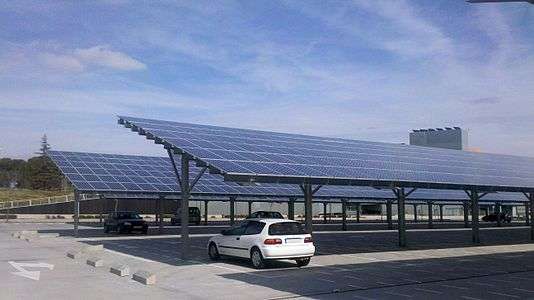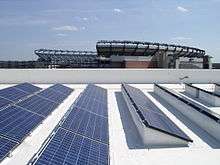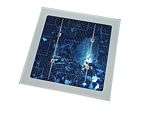Building-integrated photovoltaics
Building-integrated photovoltaics (BIPV) are photovoltaic materials that are used to replace conventional building materials in parts of the building envelope such as the roof, skylights, or facades.[1] They are increasingly being incorporated into the construction of new buildings as a principal or ancillary source of electrical power, although existing buildings may be retrofitted with similar technology. The advantage of integrated photovoltaics over more common non-integrated systems is that the initial cost can be offset by reducing the amount spent on building materials and labor that would normally be used to construct the part of the building that the BIPV modules replace. These advantages make BIPV one of the fastest growing segments of the photovoltaic industry.


The term building-applied photovoltaics (BAPV) is sometimes used to refer to photovoltaics that are a retrofit – integrated into the building after construction is complete. Most building-integrated installations are actually BAPV. Some manufacturers and builders differentiate new construction BIPV from BAPV.[2]
History
PV applications for buildings began appearing in the 1970s. Aluminum-framed photovoltaic modules were connected to, or mounted on, buildings that were usually in remote areas without access to an electric power grid. In the 1980s photovoltaic module add-ons to roofs began being demonstrated. These PV systems were usually installed on utility-grid-connected buildings in areas with centralized power stations. In the 1990s BIPV construction products specially designed to be integrated into a building envelope became commercially available.[3] A 1998 doctoral thesis by Patrina Eiffert, entitled An Economic Assessment of BIPV, hypothesized that one day there would an economic value for trading Renewable Energy Credits (RECs).[4] A 2011 economic assessment and brief overview of the history of BIPV by the U.S. National Renewable Energy Laboratory suggests that there may be significant technical challenges to overcome before the installed cost of BIPV is competitive with photovoltaic panels.[5] However, there is a growing consensus that through their widespread commercialization, BIPV systems will become the backbone of the zero energy building (ZEB) European target for 2020.[6] Despite technical promise, social barriers to widespread use have also been identified, such as the conservative culture of the building industry and integration with high-density urban design. These authors suggest enabling long-term use likely depends on effective public policy decisions as much as the technological development.[7]

Forms


There are four main types of BIPV products:
- Crystalline silicon solar panels for ground-based and rooftop power plant
- Amorphous crystalline silicon thin film solar pv modules which could be hollow, light, red blue yellow, as glass curtain wall and transparent skylight
- CIGS-based (Copper Indium Gallium Selenide) thin film cells on flexible modules laminated to the building envelope element or the CIGS cells are mounted directly onto the building envelope substrate
- Double glass solar panels with square cells inside
Building-Integrated Photovoltaic modules are available in several forms:
- Flat roofs
- The most widely installed to date is an amorphous thin film solar cell integrated to a flexible polymer module which has been attached to the roofing membrane using an adhesive sheet between the solar module backsheet and the roofing membrane. Copper Indium Gallium Selenide (CIGS) technology is now able to deliver cell efficiency of 17% as produced by a US-based company[8] and comparable building-integrated module efficiencies in TPO single ply membranes by the fusion of these cells by a UK-based company.[9]
- Pitched roofs
- Solar roof tiles are (ceramic) roof tiles with integrated solar modules. The ceramic solar roof tile is developed and patented by a Dutch company[10] in 2013.
- Modules shaped like multiple roof tiles.
- Solar shingles are modules designed to look and act like regular shingles, while incorporating a flexible thin film cell.
- It extends normal roof life by protecting insulation and membranes from ultraviolet rays and water degradation. It does this by eliminating condensation because the dew point is kept above the roofing membrane.[11]
- Metal pitched roofs (both structural and architectural) are now being integrated with PV functionality either by bonding a free-standing flexible module[12] or by heat and vacuum sealing of the CIGS cells directly onto the substrate [13]
- Facade
- Facades can be installed on existing buildings, giving old buildings a whole new look. These modules are mounted on the facade of the building, over the existing structure, which can increase the appeal of the building and its resale value.[14]
- Glazing
- Photovoltaic windows are (semi)transparent modules that can be used to replace a number of architectural elements commonly made with glass or similar materials, such as windows and skylights. In addition to producing electric energy, these can create further energy savings due to superior thermal insulation properties and solar radiation control.[15][16]
Transparent and translucent photovoltaics
Transparent solar panels use a tin oxide coating on the inner surface of the glass panes to conduct current out of the cell. The cell contains titanium oxide that is coated with a photoelectric dye.[17]
Most conventional solar cells use visible and infrared light to generate electricity. In contrast, the innovative new solar cell also uses ultraviolet radiation. Used to replace conventional window glass, or placed over the glass, the installation surface area could be large, leading to potential uses that take advantage of the combined functions of power generation, lighting and temperature control.
Another name for transparent photovoltaics is “translucent photovoltaics” (they transmit half the light that falls on them). Similar to inorganic photovoltaics, organic photovoltaics are also capable of being translucent.
Types of transparent and translucent photovoltaics
Non-wavelength-selective
Some non-wavelength-selective photovoltaics achieve semi-transparency by spatial segmentation of opaque solar cells. This method uses any type of opaque photovoltaic cell and spaces several small cells out on a transparent substrate. Spacing them out in this way reduces power conversion efficiencies dramatically while increasing transmission.[18]
Another branch of non-wavelength-selective photovoltaics utilize visibly absorbing thin-film semi-conductors with small thicknesses or large enough band gaps that allow light to pass through. This results in semi-transparent photovoltaics with a similar direct trade off between efficiency and transmission as spatially segmented opaque solar cells.[18]
Wavelength-selective
Wavelength-selective photovoltaics achieve transparency by utilizing materials that only absorb UV and/or NIR light and were first demonstrated in 2011.[19] Despite their higher transmissions, lower power conversion efficiencies have resulted due to a variety of challenges. These include small exciton diffusion lengths, scaling of transparent electrodes without jeopardizing efficiency, and general lifetime due to the volatility of organic materials used in TPVs in general.[18]
Innovations in transparent and translucent photovoltaics
Early attempts at developing non-wavelength-selective semi-transparent organic photovoltaics using very thin active layers that absorbed in the visible spectrum were only able to achieve efficiencies below 1%.[20] However in 2011, transparent organic photovoltaics that utilized an organic chloroaluminum phthalocyanine (ClAlPc) donor and a fullerene acceptor exhibited absorption in the ultraviolet and near-infrared (NIR) spectrum with efficiencies around 1.3% and visible light transmission of over 65%.[19] In 2017, MIT researchers developed a process to successfully deposit transparent graphene electrodes onto organic solar cells resulting in a 61% transmission of visible light and improved efficiencies ranging from 2.8%-4.1%.[21]
Perovskite solar cells, popular due to their promise as next-generation photovoltaics with efficiencies over 25%, have also shown promise as translucent photovoltaics. In 2015, a semitransparent perovskite solar cell using a methylammonium lead triiodide perovskite and a silver nanowire mesh top electrode demonstrated 79% transmission at an 800 nm wavelength and efficiencies at around 12.7%.[22]
Government subsidies
In some countries, additional incentives, or subsidies, are offered for building-integrated photovoltaics in addition to the existing feed-in tariffs for stand-alone solar systems. Since July 2006 France offered the highest incentive for BIPV, equal to an extra premium of EUR 0.25/kWh paid in addition to the 30 Euro cents for PV systems.[23][24][25] These incentives are offered in the form of a rate paid for electricity fed to the grid.
European Union
USA
- USA – Varies by state. Check Database of State Incentives for Renewables & Efficiency for more details.[27]
China
Further to the announcement of a subsidy program for BIPV projects in March 2009 offering RMB20 per watt for BIPV systems and RMB15/watt for rooftop systems, the Chinese government recently unveiled a photovoltaic energy subsidy program “the Golden Sun Demonstration Project”. The subsidy program aims at supporting the development of photovoltaic electricity generation ventures and the commercialization of PV technology. The Ministry of Finance, the Ministry of Science and Technology and the National Energy Bureau have jointly announced the details of the program in July 2009.[28] Qualified on-grid photovoltaic electricity generation projects including rooftop, BIPV, and ground mounted systems are entitled to receive a subsidy equal to 50% of the total investment of each project, including associated transmission infrastructure. Qualified off-grid independent projects in remote areas will be eligible for subsidies of up to 70% of the total investment.[29] In mid November, China’s finance ministry has selected 294 projects totaling 642 megawatts that come to roughly RMB 20 billion ($3 billion) in costs for its subsidy plan to dramatically boost the country’s solar energy production.[30]
Other integrated photovoltaics
Vehicle-integrated photovoltaics (ViPV) are similar for vehicles.[31] Solar cells could be embedded into panels exposed to sunlight such as the hood, roof and possibly the trunk depending on a car's design.[32][33][34][35]
See also
- Distributed generation
- Microgeneration
- Nanoinverter
- Perovskite solar cell
- Solar panel
- Renewable energy
- Roof tile
- Smart glass, a type of window blind capable of conserving energy for cooling
- Solar cell
- Solar power
- Solar thermal
- Zero-energy building
Further reading
- Agrawal, Basant; Tiwari, G N (2011). Building Integrated Photovoltaic Thermal Systems. Cambridge, UK: Royal Society of Chemistry. ISBN 978-1-84973-090-7.
- Warrick, Joby (March 2015). Utilities, sensing threat, put squeeze on booming solar roof industry. The Washington Post.
References
- Strong, Steven (June 9, 2010). "Building Integrated Photovoltaics (BIPV)". wbdg.org. Whole Building Design Guide. Retrieved 2011-07-26.
- "Building Integrated Photovoltaics: An emerging market". Retrieved 6 August 2012.
- Eiffert, Patrina; Kiss, Gregory J. (2000). Building-Integrated Photovoltaic Designs for Commercial and Institutional Structures: A Source Book for Architect. p. 59. ISBN 978-1-4289-1804-7.
- Eiffert, Patrina (1998). An Economic Assessment of Building Integrated Photovoltaics. Oxford Brookes School of Architecture.
- James, Ted; Goodrich, A.; Woodhouse, M.; Margolis, R.; Ong, S. (November 2011). "Building-Integrated Photovoltaics (BIPV) in the Residential Sector: An Analysis of Installed Rooftop System Prices." NREL/TR-6A20-53103.
- Kylili, Angeliki; Fokaides, Paris A. (2014). "Investigation of building integrated photovoltaics potential in achieving the zero energy building target". Angeliki Kylili, Paris A. Fokaides. 23 (1): 92–106. doi:10.1177/1420326X13509392.
- Temby, Owen; Kapsis, Konstantinos; Berton, Harris; Rosenbloom, Daniel; Gibson, Geoffrey; Athienitis, Andreas; Meadowcroft, James (2014). "Building-Integrated Photovoltaics: Distributed Energy Development for Urban Sustainability". Environment: Science and Policy for Sustainable Development. 56 (6): 4–17. doi:10.1080/00139157.2014.964092.
- MiaSolé website
- BIPVco technical datasheet
- ZEP BV
- Eiffert, Patrina (2000). Building-Integrated Photovoltaic Designs for Commercial and Institutional Structures: A Source Book for Architect (PDF). pp. 60–61.
- Technical datasheet for a free-standing flexible module
- Technical datasheet for a heat and vacuum-sealed CIGS cell
- Henemann, Andreas (2008-11-29). "BIPV: Built- in Solar Energy". Renewable Energy Focus. 9 (6): 14, 16–19. doi:10.1016/S1471-0846(08)70179-3.
- Vasiliev, Mikhail; et al. (2016), "Photonic microstructures for energy-generating clear glass and net-zero energy buildings", Scientific Reports, 6 (8): 4313–6, Bibcode:2016NatSR...631831V, doi:10.1038/srep31831, PMC 4994116, PMID 27550827
- Davy, N.C.; et al. (2017), "Near-UV Organic Solar Cells Paired with Electrochromic Windows for Smart Management of the Solar Spectrum", Nature Energy, 2 (8): 17104, doi:10.1038/nenergy.2017.104, PMC 17104
- West, Mike (November 1992). "Transparent PV Panel" (PDF). Energy Efficiency and Environmental News. Retrieved October 5, 2011.
- Traverse, Christopher J.; Pandey, Richa; Barr, Miles C.; Lunt, Richard R. (2017-10-23). "Emergence of highly transparent photovoltaics for distributed applications". Nature Energy. 2 (11): 849–860. Bibcode:2017NatEn...2..849T. doi:10.1038/s41560-017-0016-9. ISSN 2058-7546.
- Lunt, Richard R.; Bulovic, Vladimir (2011-03-14). "Transparent, near-infrared organic photovoltaic solar cells for window and energy-scavenging applications". Applied Physics Letters. 98 (11): 113305. Bibcode:2011ApPhL..98k3305L. doi:10.1063/1.3567516. ISSN 0003-6951.
- Bailey-Salzman, Rhonda F.; Rand, Barry P.; Forrest, Stephen R. (2006-06-05). "Semitransparent organic photovoltaic cells". Applied Physics Letters. 88 (23): 233502. Bibcode:2006ApPhL..88w3502B. doi:10.1063/1.2209176. hdl:2027.42/87783. ISSN 0003-6951.
- "Transparent, flexible solar cells combine organic materials, graphene electrodes". Main. Retrieved 2019-11-27.
- Bailie, Colin D.; Christoforo, M. Greyson; Mailoa, Jonathan P.; Bowring, Andrea R.; Unger, Eva L.; Nguyen, William H.; Burschka, Julian; Pellet, Norman; Lee, Jungwoo Z.; Grätzel, Michael; Noufi, Rommel (2015-03-05). "Semi-transparent perovskite solar cells for tandems with silicon and CIGS". Energy & Environmental Science. 8 (3): 956–963. doi:10.1039/C4EE03322A. ISSN 1754-5706. OSTI 1237896.
- "Subsidies: France moves up, Netherlands down". Eugene Standard. 2006. Archived from the original on 2006-10-04. Retrieved 2008-10-26.
30 €ct per kilowatt-hour (40 €ct for Corsica) for twenty years, while an extra premium of 25 €ct/kWh is received for roof-, wall- or window-integrated PV. Moreover, individual households also can receive a 50% tax credit for their PV investments.
- "CLER - Comité de Liaison Energies Renouvelables". CLER. 2008-06-03. Archived from the original on 2009-04-18. Retrieved 2008-10-26.
30 à 55* c€/kWh en France continentale
- PV Subsidies: France up, Netherlands down | Leonardo ENERGY Archived February 3, 2008, at the Wayback Machine
- "Feed-in Tariffs".
- "DSIRE Home". dsireusa.org. 2011. Retrieved October 5, 2011.
- "China launches "Golden Sun" subsidies for 500 MW of PV projects by 2012". snec.org.cn. SNEC PV. 2011. Archived from the original on July 7, 2011. Retrieved October 5, 2011.
China launched its much anticipated Golden Sun program of incentives for the deployment of 500 MW of large-scale solar PV projects throughout the country on July 21.
- "The Golden Sun of China". pvgroup.org. PV Group. 2011. Archived from the original on February 5, 2010. Retrieved October 5, 2011.
- Wang, Ucilia (November 16, 2009). "Here Comes China's $3B, 'Golden Sun' Projects". Greentech Media. Retrieved October 5, 2011.
- Browse Conference Publications > Ecological Vehicles and Renew ... Help Working with Abstracts Back to Results Vehicle-integrated Photovoltaic (ViPV) systems: Energy production, Diesel Equivalent, Payback Time; an assessment screening for trucks and busses
- From BIPV to Vehicle-Integrated Photovoltaics
- Opportunities for Vehicle Integrated Photovoltaics
- VIPV and infrared harvesting
- Solar vehicles
External links
- Building integrated photovoltaics an overview of the existing products and their fields of application
- Canadian Solar Buildings Research Network
- Building Integrated Photovoltaics
- PV UP-SCALE, a European founded project (contract EIE/05/171/SI2.420208) related to the large-scale implementation of photovoltaics (PV) in European cities.
